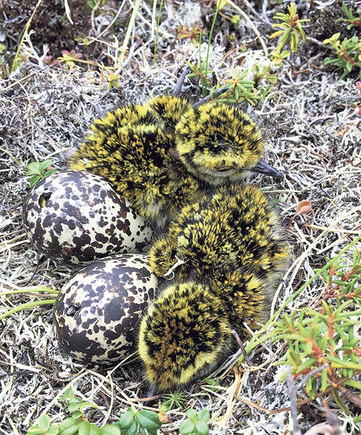Published in the Ocean Watch column, Honolulu Star-Advertiser © Susan Scott
August 6, 2016
I’ve always wondered where home was for kolea. Is it Alaska, where for about three months the Pacific golden plovers build nests, raise chicks and “forget” their winter partnerships with humans? (In kolea nesting grounds, the birds behave as if people are predators.)
Or is home in Hawaii where these migratory shorebirds spend nearly nine months of the year living in harmony with humans? I’m sure kolea fans in Hawaii share my bias: Home is here.
 A kolea nest holds two chicks and two eggs in Alaska.
A kolea nest holds two chicks and two eggs in Alaska.
The birds fly 3,000 miles to Hawaii to spend nearly nine months of the year.
Courtesy O.W. Johnson ©June 2016
Reader Bert Weeks of Aiea emailed that he saw two female plovers foraging in his neighbor’s yard July 25. On the same day another reader, Ann Egleston, saw Pacific golden plovers at the Diamond Head cemetery. By the 29th several kolea were gracing the lawns of Kapiolani Community College and the Department of Defense.
Because it takes plovers four days (nonstop) to fly here, these birds had to leave Alaska July 21. Such early returnees are probably adults that couldn’t find a mate this year, or parents that lost their brood to predators or bad weather.
Most adult kolea that successfully raised chicks arrive in Hawaii in August. Females come first, then males. After their parents leave, kolea chicks stick around the tundra for as long as the weather holds, fueling up for their 3,000-mile migration. First-year kolea navigate to Hawaii alone, on instinct, arriving in September, October and as late as November.
Only about 20 percent of each summer’s offspring live through their first year. If they make the journey, youngsters in Hawaii must then compete with stronger, experienced adults for foraging territory.
People worldwide take great pleasure in feeding wild birds, a practice endorsed by the Cornell Lab of Ornithology, the Humane Society of the United States, Birdlife International, the Royal Society for the Protection of Birds and other conservation organizations. Not all experts agree on whether backyard feeding helps bird populations overall, but they do agree that feeding can help individual birds in a neighborhood.
Feeding also connects people with nature, often profoundly, turning observers into keen citizen scientists. If you decide to feed your plover, offer it healthy food such as mealworms or bits of cooked egg. My kolea likes her eggs scrambled. Last year I learned to outsmart grabby mynahs and pushy bulbuls by luring them with a little something around a blind corner of the house. My plover caught on quickly.
When the others flew off for breadcrumbs, she stayed with me and ate her bits of egg in peace. She’s not back yet, but when she arrives I’ll drape a verbal flower lei around her neck by calling out, “Aloha, my friend! Welcome home.”